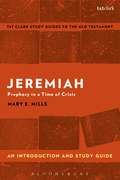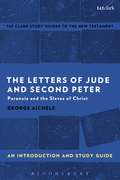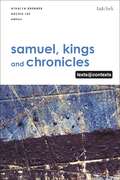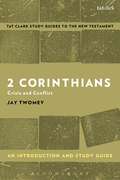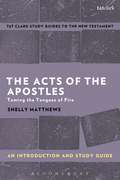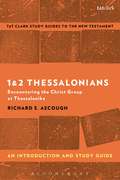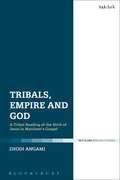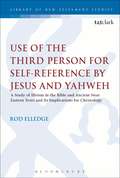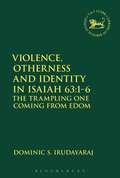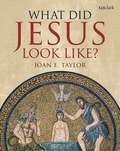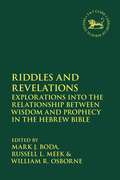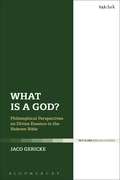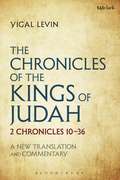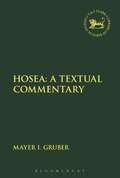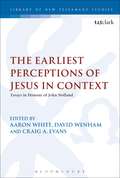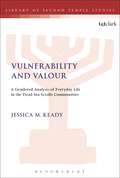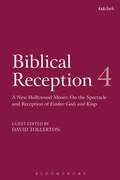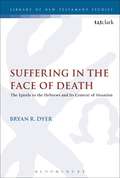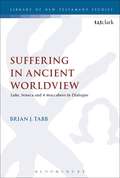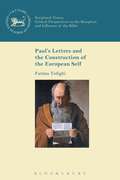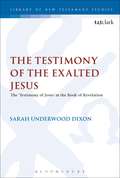- Table View
- List View
Jeremiah: Prophecy in a Time of Crisis (T&T Clark’s Study Guides to the Old Testament)
by Mary E. MillsThis guide provides a concise introduction to the ways the book of Jeremiah has been interpreted by scholars, and to new possibilities of interpretation still open to readers. Outlining approaches the reader encountering the book may best adopt, Mary E. Mills moves into the reception of the prophetic book in the modern period. The role of historical criticism has been fundamental but she shows how it should be supplemented by recent explorations into the rhetorical structures and devices by which the book communicates its messages. Historically oriented scholars drew upon the book as a record of the words and career of a prophet in monarchical Judah. Literary investigation, on the other hand, focuses on the mood and tone of the literary work. Both interpretative strands acknowledge the persistence of a mood of terror and fragmentation within Jeremiah, the result of its origins in a period of great political upheaval. Examination of the poetic devices a society uses to process its social and cultural trauma leads the reader to a deeper appreciation of the variety of sources and genres found in Jeremiah. This study guide provides reading tools which readers can then develop at their own pace.
The Letters of Jude and Second Peter: Paranoia and the Slaves of Christ (T&T Clark’s Study Guides to the New Testament)
by George AicheleThis Guide surveys the more important historical, socio-cultural, theological, and literary factors we must grapple with in understanding the two letters of Jude and Second Peter, between which there are very strong similarities. It appears that the letter of Jude was almost entirely 'plagiarized' by the letter of Second Peter. George Aichele's main approach is the method of semiotics, examining signifying mechanisms in each of the texts both independently and when they are read together. In both of the letters, Jesus Christ is called the 'master', with a Greek word that means 'slave-owner', and the authors of both books refer to themselves and other Christians as the slaves of Christ. Furthermore, both writings report situations of paranoid fear within Christian communities of their time as they picture heretical infiltrators who threaten to pervert and perhaps even destroy the community.In addition to this, in an adventurous excursion, the letter of Jude is read intertextually with the classic science fiction/horror film, Invasion of the Body Snatchers (Siegel 1956), in order to explore the dynamics of paranoia.
Samuel, Kings and Chronicles I: Texts @ Contexts (Texts @ Contexts)
by Athalya Brenner-Idan Archie C.C. LeeIn this volume scholarly voices from diverse contexts and social locations are gathered together to bring new or unfamiliar facets of biblical texts to light, focusing on issues of intertextuality. Samuel, Kings and Chronicles I sheds light from new perspectives on themes in these so-called historical books including Asian American and Chinese readings, issues of land, genealogy and maleness. The authors challenge us to consider how we deal with cultural distances between ourselves and these ancient writings - and between one another in the contemporary world. These goal of these essays is de-centre the often homogeneous first-world orientation of much biblical scholarship and open to up new possibilities for discovery of meaning and method.
2 Corinthians: Crisis and Conflict (T&T Clark’s Study Guides to the New Testament)
by Jay TwomeyThis guide considers the historical contexts, the literary forms, the social and rhetorical backgrounds, the politics, the theologies, and the reception of 2 Corinthians. Each chapter surveys recent scholarly approaches to the text, focussing especially on critical perspectives that mesh with our contemporary concerns about gender, identity, race and class. 2 Corinthians becomes, in the process, less the work of a single 1st-century writer than a set of fraught, even fractured negotiations between competing interests and impulses, conducted in Paul's voice. The last chapter brings the letter into conversation with Nathaniel Hawthorne's short story 'The Minister's Black Veil' in order to shift the terms of the critical discussion from what Paul meant to how Paul means in later cultural moments.Twomey introduces students to the way 2 Corinthians offers a fascinating but fragmentary glimpse into Paul's continuing ties with the Corinthian community. At the same time, Twomey shows how the letter is the site of many new critical challenges to traditional readings of Paul and early Christianity.In contrast to 1 Corinthians, this 2 Corinthians largely eschews the debates and discussions, the interests and concerns of Paul's correspondents. Instead we find Paul engaged in a multi-pronged defence of his ministry in and beyond Corinth. Over the course of thirteen chapters he runs the gamut of the emotions, rhetorically, from tears to joy to biting anger, while struggling to keep his relationship with (some say, his control over) the community intact.
The Acts of The Apostles: Taming the Tongues of Fire (T&T Clark’s Study Guides to the New Testament)
by Shelly MatthewsThe book of Acts opens with the dramatic story of tongues of flame descending upon believers at Pentecost and the prophecy of an egalitarian dispensation of the Spirit being fulfilled. Yet, as the narrative unfolds, we become aware of a tension between the socially egalitarian promise of the Pentecost story and the author's underlying concern to provide reassurance for his elite patron Theophilus that Jesus followers do not disturb the existing social order.In this guide, Acts is read as a struggle to tame the tongues of fire. Acts mutes the egalitarian promise of the Spirit through presenting an 'orderly account' (as its author calls it) of the Jesus movement that appeals to elite sensibilities. And, at the same time, the narrative contains contradictions, gaps and fissures that suggest the outlines of a more complex, and even subversive, religious movement.
Leader Development Deconstructed (Annals of Theoretical Psychology #15)
by Matthew G. Clark Craig W. GruberThis book examines both academic and practical theories relating to leader development. It broadens the scope of this topic by including data-driven theory and proposals from diverse areas that are either not currently represented or are poorly addressed in existing literature. This 15th volume in the Annals of Theoretical Psychology series aims to propose, identify, and characterize new theoretical, educational, and practical gaps in leader development. The initial chapters explore concepts related to individual or internal aspects of leaders. Subsequent chapters deconstruct leader development by considering behaviors or skills and various environmental factors that affect development. The book also examines shortcomings of our current understanding of this topic that cuts across multiple disciplines. Topics featured in this book include:Cognition, readiness to lead, courage through dialogue, and relationship considerations Behavioral elements and approaches for developing followership, conflict management, creativity, virtue, and epistemic cognition in growing leaders for complex environments.Seven Steps to establish a Leader and Leadership Education and Development Program. The Dark Triad of personality, psychobiosocial perspectives, and mental ability in leadersLeader Development Deconstructed will be of interest to research scholars, academics, educators, and practitioners as well as executive coaches, college or university administrators, military leaders, philanthropic and non-profit organization leaders, and management consultants. ______________________________________________________________________________"Despite the extensive body of knowledge associated with leader and leadership development, significant gaps still exist in our understanding of these processes. This book is a noteworthy effort to help fill in the blanks through empirical research and contextual application. It is worthy of perusal by anyone interested in becoming a more effective leader or leader developer."Bernard Banks, Ph.D., Associate Dean of Leadership Development, Northwestern University Kellogg School of Management "One of the most powerful ways leaders can have an impact on others and their mission is to manage for innovation... This book is a great step in moving towards exploring how you do that, and I'm thrilled to be a part of that conversation!"Frances Hesselbein, President and CEO, Frances Hesselbein Leadership Institute
1 & 2 Thessalonians: Encountering the Christ Group at Thessalonike (T&T Clark’s Study Guides to the New Testament)
by Richard S. Ascough1 Thessalonians provides a fascinating glimpse into the origins and social life of the Christ group in the ancient Roman city of Thessalonike, while 2 Thessalonians reveals how the community developed at a somewhat later time. This guide narrates the story of the founding of the group by considering the social and cultural contexts, the literary form, the rhetorical strategies, the theologies, and the reception of the two canonical letters. While centering on the texts of 1 and 2 Thessalonians themselves, Ascough draws widely on literary and archaeological data, giving particular attention to typical group behaviours among small, unofficial associations in the Greek and Roman period. The first four chapters focus on 1 Thessalonians, from the initial formation of the Christ group out of a small association of artisans through to how members negotiated various sorts of relationships: with Paul and his companions, with outsiders in Thessalonike and beyond, and especially with fellow believers within the group itself. The final two chapters turn attention to the shifting circumstances that required a second letter to be written, with its focus on disorder and disruption of social practices and theological beliefs. The epilogue briefly surveys Christianity at Thessalonike beyond the 1st century. This guide presents an overview of the historical development of the Christ group at Thessalonike. Moving beyond treating the canonical letters as simple repositories of theological opinions, Ascough demonstrates how 1 and 2 Thessalonians reveal ordinary life in ancient Roman cities. In so doing, he invites readers to enter the world of one of the many fascinating communities of Christ believers in the 1st century of the Common Era.
Tribals, Empire and God: A Tribal Reading of the Birth of Jesus in Matthew's Gospel
by Zhodi AngamiTribal biblical interpretation is a developing area of study that is concerned with reading the Bible through the eyes of tribal people. While many studies of reading the Bible from the reader's social, cultural and historical location have been made in various parts of the world, no thorough study that offers a coherent and substantive methodology for tribal biblical interpretation has been made. This book is the first comprehensive work that offers a description of tribal biblical interpretation and shows its application by making a lucid reading of Matthew's infancy narrative from a tribal reader's perspective. Using reader-response criticism as his primary method, Zhodi Angami brings his tribal context of North East India into conversation with Matthew's account of the birth of Jesus. Since tribal people of North East India see themselves as living under colonial rule, a tribal reader sees Matthew's text as a narrative that actively resists and subverts imperial rule. Likewise, the tribal experience of living at the margins inspires a tribal reader to look at the narrative from the underside, from the perspective of those who are sidelined, ignored, belittled or forgotten. Tribal biblical interpretation presented here follows a process of conversation between tribal worldview and Matthew's narrative. Such a method animates the text for the tribal reader and makes the biblical narrative not only more intelligible to the tribal reader but allows the text to speak directly to the tribal context.
Use of the Third Person for Self-Reference by Jesus and Yahweh: A Study of Illeism in the Bible and Ancient Near Eastern Texts and Its Implications for Christology (The Library of New Testament Studies #575)
by Rod ElledgeWhile an individual referring to themselves in the third person may sound unusual, this phenomenon (known as illeism) is consistently and extensively reflected in the direct speech of both Jesus and Yahweh. This in turn raises various questions: why are Jesus and Yahweh presented as speaking in such a manner? Who else employs illeism in the Bible? Does it occur in the Ancient Near Eastern texts, and, if so, who utilises it? And lastly, is there a relationship between the illeism as used by Yahweh, and the illeism as used by Jesus?Elledge addresses an issue in Biblical texts often neglects by scholarship: conducting an extensive survey of the use of illeism in the Bible and the Ancient Near Eastern Texts, and presenting evidence that this phenomenon, as used by Jesus, reflects both royal and divine themes that are apparent across several different religions and cultures. Through Elledge's examinations of illeism in Classical Antiquity, Ancient Near Eastern texts and the Old and New testament, this book provides a fresh perspective on the divine use of the third person, contributing substantial analysis to the on-going discussion of Jesus' divinity and self-understanding.
Violence, Otherness and Identity in Isaiah 63: The Trampling One Coming from Edom (The Library of Hebrew Bible/Old Testament Studies #633)
by Dominic S. IrudayarajViolence disturbs. And violent depictions, when encountered in the biblical texts, are all the more disconcerting. Isaiah 63:1-6 is an illustrative instance. The prophetic text presents the "Arriving One" in gory details ('trampling down people'; 'pouring out their lifeblood' v.6). Further, the introductory note that the Arriving One is “coming from Edom” (cf. v.1) may suggest Israel's unrelenting animosity towards Edom. These two themes: the "gory depiction" and "coming from Edom" are addressed in this book.Irudayaraj uses a social identity reading to show how Edom is consistently pictured as Israel's proximate and yet 'other'-ed entity. Approaching Edom as such thus helps situate the animosity within a larger prophetic vision of identity construction in the postexilic Third Isaian context. By adopting an iconographic reading of Isaiah 63:1-6, Irudayaraj shows how the prophetic portrayal of the 'Arriving One' in descriptions where it is clear that the 'Arriving One' is a marginalised identity correlates with the experiences of the "stooped" exiles (cf 51:14). He also demonstrates that the text leaves behind emphatic affirmations ('mighty' and 'splendidly robed' cf. v.1; “alone” cf. v.3), by which the relegated voice of the divine reasserts itself. It is in this divine reassertion that the hope of the Isaian community's reclamation of its own identity rests.
What Did Jesus Look Like?
by Joan E. TaylorJesus Christ is arguably the most famous man who ever lived. His image adorns countless churches, icons, and paintings. He is the subject of millions of statues, sculptures, devotional objects and works of art. Everyone can conjure an image of Jesus: usually as a handsome, white man with flowing locks and pristine linen robes.But what did Jesus really look like? Is our popular image of Jesus overly westernized and untrue to historical reality?This question continues to fascinate. Leading Christian Origins scholar Joan E. Taylor surveys the historical evidence, and the prevalent image of Jesus in art and culture, to suggest an entirely different vision of this most famous of men. He may even have had short hair.
Riddles and Revelations: Explorations into the Relationship between Wisdom and Prophecy in the Hebrew Bible (The Library of Hebrew Bible/Old Testament Studies)
by Mark J. Boda Russell L. Meek William R. OsborneA comprehensive examination of the links between wisdom literature and prophecy. The book is divided into four sections. The first addresses methodological concerns such as identifying “wisdom,” identifying potential sociological spheres for wisdom and prophecy in the ancient Near East, and recognizing potential textual relationships. The second examines the role of wisdom in the prophetic corpus more broadly in a book-by-book analysis of biblical texts, first examining the role of wisdom in the prophetic corpus of the Hebrew Bible. The third section looks at elements of prophecy within the traditional wisdom books such as Job, Proverbs and Qoheleth. Finally, the book continues the conversation by providing two concluding chapters that evaluate, critique, engage, and raise new questions that Hebrew Bible scholars will need to wrestle with as the search for the relationship between wisdom and prophecy moves forward.
What is a God?: Philosophical Perspectives on Divine Essence in the Hebrew Bible
by Jaco GerickeIn this book Jaco Gericke is concerned with different ways of approaching the question of what, according to the Hebrew Bible, a god was assumed to be. As a supplement to the tradition of predominantly linguistic, historical, literary, comparative, social-scientific and related ways of looking at the research problem, Gericke offers a variety of experimental philosophical perspectives that aim to take a step back from the scholarly discussion as it has unfolded hitherto in order to provide a new type of worry when looking at the riddle of what the biblical texts assumed made a god divine. Consisting of a brief history of philosophical interpretations of the concepts of whatness and essence from Socrates to Derrida, the relevant ideas are adapted and reapplied to look at some interesting metaphysical oddities arising from generic uses of elohim/el/eloah as common noun in the Hebrew Bible. As such the study seeks to be a prolegomenon to all future research in that, instead of answering the question regarding a supposed nature of divinity, it aims to complicate it beyond expectation. In this way a case is made for a more nuanced and indeterminate manner of constructing the problem of what it meant to call something a god.
The Chronicles of the Kings of Judah: 2 Chronicles 10 - 36: A New Translation and Commentary
by Yigal LevinThe book of Chronicles, the last book of the Hebrew Bible and a central historical book of the Christian Old Testament, has in recent decades gone from being “the Cinderella of biblical studies” to being one of the most researched books of the Bible. The anonymous author, often simply called “the Chronicler” by modern scholars, looks back at the old Israelite monarchy, before the Babylonian Exile, from his vantage point in the post-exilic early Second Temple Period, and attempts to “update” the older historiographies of Samuel and Kings in order to elucidate their meaning to the people of his own time. In The Chronicles of the Kings of Judah, Yigal Levin does the same for the modern reader. He offers a brand-new translation and commentary on 2 Chronicles chapters 10-36, tracing the “sacred history” of the monarchy from the division of Solomon's kingdom to the final exile and return. Each chapter is translated from the original Hebrew into an English that is both faithful to the original and easy for the modern reader to follow. Extensive footnotes provide full explanations of the translator's choices and of linguistic and literary issues, taking note of alternative versions offered by a wide array of ancient and modern versions and translations. The comprehensive commentary on each section provides historical background and explains the text both on a literary and a historical level, making full use of the most up-to-date research on the text, literature, history, geography and on the archaeological background of the biblical world.The Chronicles of the Kings of Judah is to be followed by The Chronicles of David and Solomon on 1 Chronicles 10 – 2 Chronicles 9, and then by The Chronicles of All Israel on the genealogies of 1 Chronicles 1-9 and including comprehensive essays on the book of Chronicles, its time, purposes, methods and meanings.
Hosea: A Textual Commentary (The Library of Hebrew Bible/Old Testament Studies #653)
by Mayer I. GruberMayer I. Gruber provides a new commentary on and translation of Hosea. Building upon his work that debunked the myth of sacred prostitution, Gruber now goes on to show that the book of Hosea repeatedly advocates a single standard of marital fidelity for men and women and teaches cheated women to fight back. Gruber employs the latest and most precise findings of lexicography and poetics to solve the difficulties of the text and to determine both how Hosea can be read and what this means. The translation differs from classical and recent renderings in eliminating forms and expressions, which are neither modern English nor ancient Hebrew. Referring to places, events, and material reality of the 9th and 8th centuries BCE, Gruber uncovers the abiding messages of the heretofore obscure book of Hosea. As in previous studies, Gruber employs the insights of behavioral sciences to uncover forgotten meanings of numerous allusions, idioms, similes, and metaphors. Judicious use is made also of textual history, reception history, and personal voice criticism. One of the least biblical books now speaks more clearly to present and future audiences than it did to many previous audiences.
The Earliest Perceptions of Jesus in Context: Essays in Honor of John Nolland (The Library of New Testament Studies #566)
by Aaron White David Wenham Craig A. EvansThis volume contributes to the study of the identity of Jesus, focusing on how he was originally perceived both by his contemporaries and in the earliest Christian writings. The essays include studies of methodology, archaeology, background, individual gospel perspectives, gospel relationships,intertextuality in the gospels, the earliest reception of the Jesus tradition in the post-Easter writings of the New Testament, and the missiological and pedagogical implications of Jesus' teaching.John Nolland is the reason for this volume, and his important writings on the gospels are its backdrop. The contributors, who include N.T. Wright, Craig Evans, Darrell Bock, Rainer Riesner and Roland Deines, pay tribute to Nolland's work and ideas, by drawing on his writings, and by exploring questions and issues close to his heart.
Vulnerability and Valour: A Gendered Analysis of Everyday Life in the Dead Sea Scrolls Communities (The Library of Second Temple Studies #91)
by Jessica M. KeadyJessica M. Keady uses insights from social science and gender theory to shed light on the Dead Sea Scrolls and the community at Qumran. Through her analysis Keady shows that it was not only women who could be viewed as an impure problem, but also that men shared these characteristics as well. The first framework adopted by Keady is masculinity studies, specifically Raewyn Connell's hegemonic masculinity, which Keady applies to the Rule of the Community (in its 1QS form) and the War Scroll (in its 1QM form), to demonstrate the vulnerable and uncontrollable aspects of ordinary male impurities. Secondly, the embodied and empowered aspects of impure women are revealed through an application of embodiment theories to selected passages from 4QD (4Q266 and 4Q272) and 4QTohorot A (4Q274). Thirdly, sociological insights from Susie Scott's understanding of the everyday - through the mundane, the routine and the breaking of rules - reveal how impurity disrupts the constructions of daily life. Keady applies Scott's three conceptual features for understanding the everyday to the Temple Scroll (11QTa) and the Rule of the Congregation (1QSa) to demonstrate the changing dynamics between ordinary impure males and impure females. Underlying each of these three points is the premise that gender and purity in the Dead Sea Scrolls communities are performative, dynamic and constantly changing.
The Apostolic Fathers and Paul (Pauline and Patristic Scholars in Debate #2)
by Todd D. Still David E. WilhiteBuilding on the work of Tertullian and Paul this volume continues a series of specially commissioned studies by leading voices in New Testament/Early Christianity and Patristics studies to consider how Paul was read, interpreted and received by the Church Fathers. In this volume the use of Paul's writings is examined within the work of the Apostolic Fathers. Issue of influence, reception, theology and history are examined to show how Paul's work influenced the developing theology of the early Church. The literary style of Paul's output is also examined. The contributors to the volume represent leading lights in the study of the Apostolic Fathers, as well as respected names from the field of New Testament studies.
Biblical Reception, 4: A New Hollywood Moses: On the Spectacle and Reception of Exodus: Gods and Kings (Biblical Reception)
by David TollertonBiblical Reception is rapidly becoming the go-to annual publication for all matters related to the reception of the bible. The annual addresses all kinds of use of the bible in art, music, literature, film and popular culture, as well as in the history of interpretation. For this fourth edition of the annual, guest editor David Tollerton has commissioned pieces specifically on the use of the bible in one film: Exodus: Gods and Kings and these chapters consider how the film uses the bible, and how the bible functions within the film.
Suffering in the Face of Death: The Epistle to the Hebrews and Its Context of Situation (The Library of New Testament Studies #568)
by Bryan R. DyerSuffering and death are two topics that are frequently referred to in the Epistle to the Hebrews, but have rarely been examined within scholarship on this important New Testament text. Dyer redresses the balance in this study of these topics, conducting a thorough investigation using semantic domain analysis. He incorporates recent advancements in modern linguistics, in particular the 'context of situation', and then connects these topics to the social situation addressed in Hebrews. In so doing he is able to reveal how the author is responding to the reality of suffering in the lives of his audience. With this awareness, it becomes clear how the author also responds to his audience's pain by creating models of endurance in suffering and death. These serve to motivate his audience toward similar endurance within their own social context.Dyer shows that it is possible to make significant determinations about the social setting of Hebrews based upon an examination and analysis of the language used therein.
The Influence of Post-Biblical Hebrew and Aramaic on the Translator of Septuagint Isaiah (The Library of Hebrew Bible/Old Testament Studies)
by Seulgi L. ByunFor many years, scholars have noted that post-biblical Hebrew and Aramaic may have influenced some of the renderings in the ancient Greek versions of the Hebrew Bible, but examination of this has usually been done only in passing with little or no discussion and scant evidence. Seulgi L. Byun examines the ancient Greek version of Isaiah, commonly referred to as LXX (Septuagint) Isaiah, and examines a number of possible cases in depth in order to determine the degree to which semantic change within Hebrew, as well as the spread of Aramaic already in the Second Temple period, may have influenced the translator.The book begins with an overview of key issues (semantic change; the development (or non-development) of the Hebrew language; previous scholarship; issues in the study of LXX Isaiah; and methodological considerations). This is followed by four larger sections representing various categories of examples where post-biblical Hebrew or Aramaic may have influenced renderings in the text, each offering specific examples. The first section contains examples where post-biblical Hebrew may have influenced LXX Isaiah; the second section offers examples of Aramaic influence; the third section addresses examples where the influence is not clear (possibly both post-biblical Hebrew and Aramaic); and the fourth section discusses the possibility of word manipulation - cases where the translator of LXX Isaiah 'manipulated' the Hebrew with a post-biblical Hebrew or Aramaic meaning/word in mind.
Principles and Practice of Case-based Clinical Reasoning Education: A Method for Preclinical Students (Innovation and Change in Professional Education #15)
by Olle Ten Cate Eugène J.F.M. Custers Steven J. DurningThis book is open access under a CC BY 4.0 license. This volume describes and explains the educational method of Case-Based Clinical Reasoning (CBCR) used successfully in medical schools to prepare students to think like doctors before they enter the clinical arena and become engaged in patient care. Although this approach poses the paradoxical problem of a lack of clinical experience that is so essential for building proficiency in clinical reasoning, CBCR is built on the premise that solving clinical problems involves the ability to reason about disease processes. This requires knowledge of anatomy and the working and pathology of organ systems, as well as the ability to regard patient problems as patterns and compare them with instances of illness scripts of patients the clinician has seen in the past and stored in memory. CBCR stimulates the development of early, rudimentary illness scripts through elaboration and systematic discussion of the courses of action from the initial presentation of the patient to the final steps of clinical management. The book combines general backgrounds of clinical reasoning education and assessment with a detailed elaboration of the CBCR method for application in any medical curriculum, either as a mandatory or as an elective course. It consists of three parts: a general introduction to clinical reasoning education, application of the CBCR method, and cases that can used by educators to try out this method.
Suffering in Ancient Worldview: Luke, Seneca and 4 Maccabees in Dialogue (The Library of New Testament Studies #569)
by Brian J. TabbSuffering in Ancient Worldview investigates representative Christian, Roman Stoic and Jewish perspectives on the nature, problem and purpose of suffering. Tabb presents a close reading of Acts, Seneca's essays and letters and 4 Maccabees, highlighting how each author understands suffering vis-à-vis God, humanity, the world's problem and its solution, and the future. Tabb's study offers a pivotal definition for suffering in the 1st century and concludes by creatively situating these ancient authors in dialogue with each other. Tabb shows that, despite their different religious and cultural positions, these ancient authors each expect and accept suffering as a present reality that is governed by divine providence, however defined. Luke, Seneca and the author of 4 Maccabees each affirm that suffering is not humanity's fundamental problem. Rather, suffering functions as a cipher for other things to be displayed. For Seneca, suffering provides an opportunity for one to learn and show virtue. The author of 4 Maccabees presents the nation's suffering as retribution for sin, while the martyrs' virtuous suffering leads to Israel's salvation. For Luke, the Lord Jesus suffers to accomplish salvation and restoration for the world marred by sin and suffering, and the suffering of his followers is instrumental for Christian mission.
Paul's Letters and the Construction of the European Self (The Library of New Testament Studies)
by Fatima TofighiEven when he was a prototype of European identity, Paul transgressed the limits of Europe. It is not clear whether he was conformist or rebellious, orthodox or liberal, sexist, or egalitarian. Instead of pushing the Apostle into the arbitrary categories of modern European identity, Fatima Tofighi takes into account the challenge that Paul brings to normative conceptions of political theology (Rom 13), 'religion' (Gal 2.12-14), and women's veiling (1 Cor 11. 5-16). Alternative interpretations of these passages, with the help of postmodern theory, both solve the major problems of biblical exegesis and offer a critique of the allegedly well-defined European categories.
The Testimony of the Exalted Jesus: The 'Testimony of Jesus' in the Book of Revelation (The Library of New Testament Studies #570)
by Sarah Underwood DixonThe interpretation of the phrase 'the testimony of Jesus' in the Book of Revelation has been the centre of much debate, with no clear consensus regarding its meaning. One of the most important but often neglected issues is whether or not the phrase can be read consistently across each instance of its occurrence. The opening lines of the Apocalypse clearly specify that 'the testimony of Jesus' is a moniker for the book of Revelation itself, indicating that the phrase is an internal self-reference to the book's own message. Nevertheless, most interpreters are reluctant to apply this interpretation to the phrase in other parts of the book, leading to varied and inconsistent interpretations of the phrase.Following the intratextual pattern of the apocalyptic books of Daniel and 1 Enoch we can see that it is entirely possible that 'the testimony of Jesus' is a reference to Revelation's own message, an interpretation which is then supported by Dixon's in-depth study of each of the passages in which the phrase occurs. The exploration of the rhetorical impact of interpreting the phrase in this way shows that 'the testimony of Jesus' is not just another title for John's writing, but is something that is given to and even characterizes those who hear the message of the Apocalypse.
